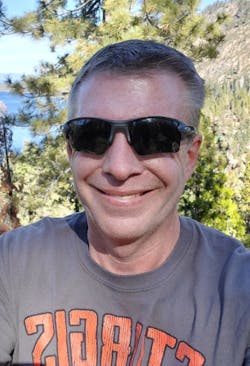What you’ll learn:
- Firsthand accounts of interactions with Silicon Valley’s pioneers.
- How Seiko’s first quartz watch came into being.
- Tim McCune’s retirement from being a corporate exec.
The building at 365 East Middlefield Road in Mountain View is almost Soviet-style in its utilitarian design. A relic of the early 1960s, with few cosmetic or other improvements since then, it holds more memories and history than other structures in the backwaters of Silicon Valley. It’s mostly empty, aside from a small IT company renting a corner of it.
The story of Linear Integrated Systems, the small semiconductor company at which I served as president of until recently, could begin many places, but East Middlefield Road is as good a spot as any. A quick internet search will tell you the building is an EPA Superfund Priorities List Site, and Google Maps even labels the building as such. Linear Systems has not, and has never had, any direct association with the property. But in 1963, the company’s founder, John H. Hall, proudly built his first semiconductor fab there.
Hall, Hoerni, and Shockley
Hall had been the protégé of famed Silicon Valley founder Jean Hoerni after they’d worked together at Teledyne, building a radiation-hardened computer for the SR-71 Blackbird. Hoerni was one of the so-called Traitorous Eight who’d left William Shockley’s employ in 1957 to start Fairchild Semiconductor. Both Hall and Hoerni left Teledyne in 1962 to start Union Carbide’s nascent semiconductor operation.
Hall told me Shockley was the person who led the Bell Labs’s team in the right direction, and that his technical brilliance was beyond dispute. But Shockley, often called the father of the semiconductor industry, was by all accounts abusive and distrustful to the point of paranoia. Scattering former protégés such as Hoerni around Silicon Valley like apple seeds, much of the industry, like Linear Systems, can in some way trace its roots back to him. Hoerni, to some extent, was cut of the same cloth, with a few edges trimmed by Shockley himself.
Shockley, perhaps in a bit of foreshadowing, popped up a couple of times in my life, long before I’d ever thought of working in semiconductors. In 1973, my dad, a Bell Labs switching systems design engineer, proudly brought home a first day of issue postal cover with former Bell Labs employees Shockley, John Bardeen, and Walter Brattain pictured. The trio had won the 1956 Nobel Prize for inventing the transistor, and the USPS included them in a series featuring the electronics industry. Shockley was a household hero, and I was proud that my dad was a part of his world.
Hoerni had maintained a polite professional relationship with Shockley, and he would bring Hall to visit him from time to time. Though Hoerni had frequently criticized Hall harshly, often in front of their subordinates, the meetings with Shockley were polite and professional. But when I asked Hall something to the effect of whether Shockley was crazy or a jerk, his answer was simply, “Yes.”
From Union Carbide to Intersil to Micro Power Systems
Union Carbide’s East Middlefield Road location was home to many semiconductor firsts, from thin-film resistors to monolithic dual bipolars. While proud of these technical achievements, Hall also expressed regret that the fab had also been home to waste and excess chemicals being dumped into drains and onto the grounds around the building, as was often the practice in the industry’s early days.
In 1967, Union Carbide moved its operations to San Diego and sold its fab to the newly started Intel Corp the next year. Hall attributed Union Carbide’s decision to an executive wanting to be closer to his sailboat, and he and Hoerni left to co-found Intersil.
Hoerni sent Hall to Switzerland to work on an electronic watch design. When Hall succeeded in developing the first useful CMOS IC for this project, and the Swiss declined to put it into production, they sold it to a then-small Japanese watch company, Seiko. Seiko funded Hall in a startup semiconductor company, Micro Power Systems, which grew quickly under his leadership.
Shocking Shockley Revelations
I never met Shockley, but he again entered my life when I was an undergraduate research assistant to Professor Clark Mollenhoff, a Pulitzer prize-winning reporter and lawyer. Testifying as an expert witness on the narrow technical issue of malice in a libel suit Shockley had brought, my professor was almost apologetic as he explained that First Amendment cases often involved people with highly offensive views. Like Bill Shockley’s.
Shockley, not content to mistreat people within his professional reach, by the 1960s began to develop detailed theories concerning race and human intelligence, claiming Blacks as a group were intellectually inferior to Whites and East Asians. By the time my friend and mentor Mollenhoff testified in that First Amendment case in 1984, Shockley was rightfully consigned to pariah status in Silicon Valley and elsewhere. Shockley won his libel case, but as his reputation was deemed to have no value, the judge awarded him just one dollar.
I met Hall in 1989 after he came to Washington, DC, to testify before a Senate panel on the issue of Japan trying to dominate the world semiconductor industry. Hall’s benefactor at Seiko, Ichiro Hattori, had died on a golf course in 1987. Seiko’s new leaders and Hall clashed, leading to his forced departure from Micro Power Systems, something that received attention from the Wall Street Journal and other publications. Hall made friends with congressional staffers who were my friends as well, and we soon ended up spending evenings discussing issues of the day at Capitol Hill watering holes.
After his departure from Micro Power Systems, Hall in 1987 founded Linear Systems, largely as a designer and manufacturer of ultra-low-noise JFETs and bipolar transistors. He was well known within industry circles, and the San Francisco Chronicle in 1992 referred to him as “one of Silicon Valley’s unsung innovators.” His long relationships with test-equipment manufacturers and other companies brought in-house accounts that formed the basis for the company’s business.
Hall and I kept crossing paths, partly because I found some interesting projects that helped pay the bills and partly because we enjoyed each other’s company. In 1994, I left journalism to work at an engineering consulting firm’s new Washington, DC office, and there I found a project supporting the Navy’s work on RF weapons defenses that we worked on together.
Developing a “Voice” at Integrated Wave Technologies
In 1992, Hall started a company to commercialize speech-recognition technology developed in the former Soviet Union. He and I wrote successful proposals for Justice Department, Office of Naval Research, Air Force Research Labs, and DARPA funding. We built prototypes of body-worn voice-to-voice language translation systems, and after 9/11, the technology proved itself to be uniquely capable on battlefields. In 2004, Hall asked me to come work for him and lead that company—Integrated Wave Technologies, Inc.
The work at IWT went well. Hall’s vision combined with the talents of our Russian design team produced electronic devices that became the favorites of DARPA and U.S. military personnel. I visited Russia 50 times to work on the designs and then traveled to Iraq and Afghanistan to train users and test systems in the field. The company generated much-appreciated cash, a lot of which was pumped into Linear Systems to revive its then-slumping fortunes.
By 2012, the business at Integrated Wave Technologies had run its course, and Hall’s health was declining. He asked me if I would come over to Linear Systems and eventually succeed him as president. Over the next two years, I worked closely with him to learn as much as I could about the business. Revenue had been declining, year over year, and there were significant challenges for the company.
Taking the Reins at Linear Systems
Hall passed away in 2014, and we did our best to run the company according to the principles, strategies, and tactics he had imparted to us. To a large extent, we were successful, going on an eight-year stretch of year-over-year revenue increases. Customers ranging from studio microphone manufacturers to military underwater listening system designers came to rely on Linear Systems’ parts.
A big part of this success was the advice I received from other industry veterans. By chance, I learned of an annual dinner called Analog Aficionados started by the late Jim Williams, an applications legend at Linear Technology. Paul Rako, an irrepressibly affable veteran engineer, had taken over running the event. When Rako retired and left Silicon Valley for Florida, he offered me the opportunity to take over hosting the event.
Agreeing to that was one of the best decisions I’ve made. The loosely organized group is composed of many industry veterans who have been generous with their time and counsel. I met then Maxim Integrated CEO Tunç Doluca, Linear Technology founder Bob “Dobby” Dobkin, and many others through the Analog Aficionados dinners.
Soon after Hall’s passing, I asked Dobby if I could come to him for help with Linear Systems, and he said absolutely. Advice ranging from datasheet tips—“always state your competitive advantage on top”—to collecting and disseminating relevant circuit schematics, which became our FET Friday social media posts, helped build our business. His insights, advice, and counsel have been key to our success over the past 10 years.
Passing the Torch
After 30 years, some two-million air miles, a couple thousand nights in hotel rooms, and a great run at John Hall’s companies, I decided to take a long-overdue break from corporate management. Linear Systems continues in the able hands of others who have spent many years there. I’m now helping my old friend Mike Engelhardt, and new friends at Qorvo, build a following for his new circuit simulation software, QSPICE, while making more time for my kids and grandkids.
Early on in our relationship, Hall made a point of telling me he wasn’t going to treat me or anyone the way Shockley had treated Hoerni, or Hoerni had treated him. That generation of leadership—people like Hall, Dobby and Tunç—showed you could achieve technical and financial success while treating people with courtesy and respect. They devised and implemented technology to prevent fab operations from harming the environment.
In many ways that matter, it’s a better industry now than it was at the beginning, and it’s been my good fortune to know some of the people who made it that way.
About the Author

Tim McCune
Qorvo Consultant
Tim McCune is a consultant for Qorvo, supporting marketing and partnership development of its QSPICE circuit simulation application authored by Mike Engelhardt. Tim recently retired as president of Linear Integrated Systems Inc., after 10 years. Prior to that, he was president of Integrated Wave Technologies Inc., a developer of speech-recognition systems for DARPA and other customers. Tim has served for the past 12 years as the host of the Analog Aficionados annual industry dinner.

